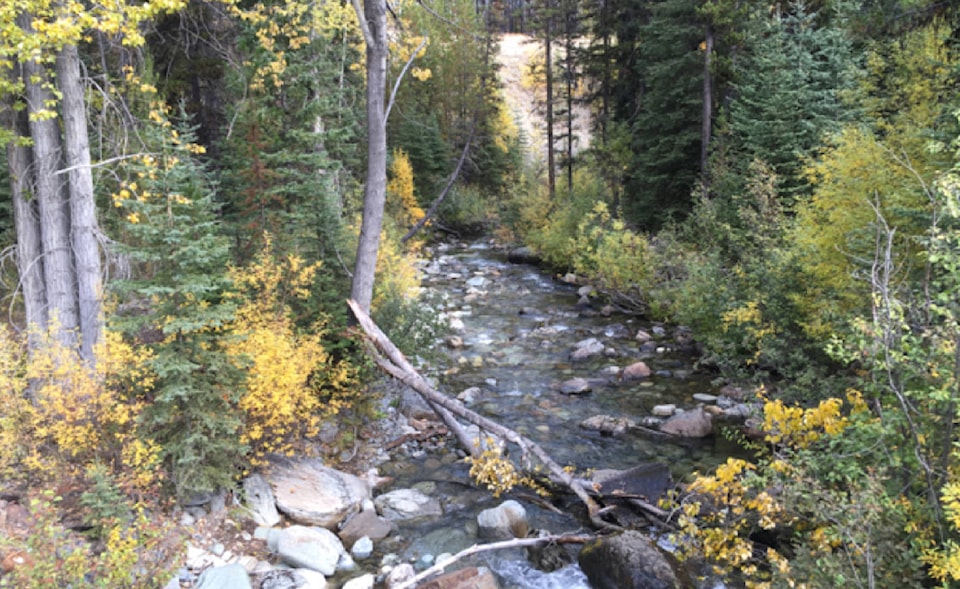Each year, Kimberley City Council receives an annual report on the quality of Kimberley’s source drinking water in Mark and Matthew creeks. Council received the 2018 report at their regular meeting Tuesday evening.
The report provides an annual overview of raw source water quality in the two creeks that provide Kimberley’s drinking water.
The report indicates that both Mark and Matthew Creek met all standards under the BC Drinking Water Protection Regulation.
“Water quality in both Mark and Matthew Creek was good and stable in 2018, though as usual, turbidity was high during freshet. Once water levels stabilized, raw water quality was excellent,” the report says.
Water quality samples were taken at ten sites in Mark Creek and three sites in Matthew Creek, the report says. Continuous monitoring equipment was deployed from mid-May to early October
in Mark Creek and mid-May to mid-October in Matthew Creek. Peak snow pack was 229 per cent of normal on May 1st at the Sullivan Mine snow course, very rapid snow melt occurred in the first two weeks of May reducing the snow pack earlier than normal.
This monitoring helps the City monitor effects or changes in water quality over time. With different activities in the watershed, it is important to have a base line data set.
This data compares and monitors sites where activities happen, making it possible to see the effects on the water quality. This sampling also helps the City move towards a filtration deferral.
The City spends up to $47,720 per year on monitoring the watersheds, and activities associated with that. BC Timber Sales, who operate in the Mark Creek watershed, contribute $10,000 toward the sampling, as per an memorandum of understanding between them and the City signed in May of this year.
The report also makes a number of recommendations:
1. UV disinfection should be added to the City of Kimberley system to meet condition 1 of the Drinking Water Treatment Objectives (DWTO) and enable the City to apply for a filtration deferral.
2. Mark Creek should be put forward as a case study to test the new Cumulative Effects Framework protocols for aquatic ecosystems, old growth forests and, when the protocol is available, forest biodiversity.
3. An Integrated Watershed Management Plan (IWMP) should be developed for Matthew Creek now that revised Mark Creek IWMP is complete.
4. The Mark Creek road closure should be published in the hunting regulations and readily visible on the Rocky Mountain Forest District website.
5. In order to further strengthen its watershed control program and potential for filtration deferral, the City should continue to work with BC Timber sales (BCTS), Teck and Canfor to enforce the motorized closure in Mark Creek. Continued vigilance and education are key. Increased recreational use places the watershed at risk of contamination from human waste and significantly increasesthe risk of fire.
6. Activities relating to firesmart or interface fire planning near either watershed should be referred through the watershed advisory committee to ensure efforts are coordinated amongst all stakeholders and licensees to provide the best possible protection for both the watersheds and the community.
7. The City should test for Cryptosporidium and Giardia parasites at both chlorination plants and at Site 7 in Mark Creek.
8. The City should work with BC Timber Sales to stabilize the eroding slope upstream of the second bridge in Mark Creek to minimize the risk of future slope failure and subsequent turbidity in the source water for the City.
9. Steam gauging (flow monitoring) should be reinstated on both Mark and Matthew Creek, in addition to the present water level monitoring. This information is critical for understanding long-term trends in water supply as snowpack and rainfall patterns change and forest cover is altered.
10. A remote monitoring station should be installed on Matthew Creek, comparable to the Mark Creek system.
11. The limit of the City’s turbidity data recorder at the Mark Creek Chlorine Plant (currently 20 NTU) should be raised to allow direct comparison with the turbidity sensor at the remove station upstream, if possible without losing precision.
